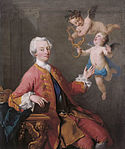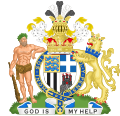Duke of Edinburgh
| Dukedom of Edinburgh | |
|---|---|
 | |
| Creation date | 10 March 2023 (announced)[1] 3 April 2023 (Letters Patent)[2] |
| Creation | Fourth |
| Created by | Charles III |
| Peerage | Peerage of the United Kingdom |
| First holder | Prince Frederick (first creation; 1726) |
| Present holder | Prince Edward |
| Subsidiary titles | Earl of Wessex Earl of Forfar Viscount Severn |
| Status | Extant |
Duke of Edinburgh, named after the city of Edinburgh in Scotland, is a substantive title that has been created four times since 1726 for members of the British royal family. It does not include any territorial landholdings and does not produce any revenue for the title-holder.
The current holder,
1726 creation

The title was first created in the
1866 creation
Queen Victoria re-created the title, this time in the Peerage of the United Kingdom, on 24 May 1866 for her second son Prince Alfred, instead of Duke of York, the traditional title of the second son of the monarch. The subsidiary titles of the dukedom were Earl of Kent and Earl of Ulster, also in the Peerage of the United Kingdom.[7] When Alfred became the Duke of Saxe-Coburg and Gotha in 1893, he retained his British titles. His only son that survived birth, Alfred, Hereditary Prince of Saxe-Coburg and Gotha, committed suicide in 1899, so the Dukedom of Edinburgh and subsidiary titles became extinct upon the elder Alfred's death in 1900.[3]
1947 creation
The title was created for a third time on 19 November 1947 by King
Upon Philip's death on 9 April 2021, his eldest son,
2023 creation
It was announced in 1999, at the time of
Prince Philip died in April 2021. His dukedom was inherited by his eldest son, Prince Charles, who was to give it to Edward upon becoming king according to Philip's wish. Edward, who had by then dropped to the 14th place in the line of succession because of births of those higher in line, said in June that him getting such a prestigious title was "a pipe dream of my father's".
It was suggested in November 2022, shortly after Charles III ascended the throne, that Buckingham Palace was considering saving the dukedom for the new king's granddaughter Princess Charlotte of Wales in recognition of her high place in the line of succession and her being the first female member of the royal family whose place in the line of succession cannot be superseded by a younger brother.[15]
The dukedom was bestowed on Prince Edward on the occasion of his 59th birthday on 10 March 2023.
Dukes of Edinburgh
First creation, 1726
Also:
| Duke | Portrait | Birth | Marriage(s) | Death |
|---|---|---|---|---|
| Prince Frederick House of Hanover 1726–1751 also: Prince of Wales (1728), Duke of Cornwall (1727, created 1337), Duke of Rothesay (1727, created 1469) |

|
1 February 1707 Leineschloss, Hanover son of King George II and Queen Caroline |
Princess Augusta of Saxe-Gotha 17 April 1736 9 children |
31 March 1751 Leicester House, Leicester Square, London aged 44 |
| Prince George House of Hanover 1751–1760 also: Prince of Wales (1751) |

|
4 June 1738 Norfolk House, London son of Prince Frederick and Princess Augusta |
Princess Charlotte of Mecklenburg-Strelitz 8 September 1761 15 children |
29 January 1820 Windsor Castle, Windsor aged 81 |
| Prince George succeeded as George III in 1760 upon his merged in the Crown .
| ||||
Second creation, 1866
Also: Earl of Kent and Earl of Ulster.
| Duke | Portrait | Birth | Marriage(s) | Death |
|---|---|---|---|---|
Duke of Saxe-Coburg and Gotha (1893)
|

|
6 August 1844 Prince Albert
|
Grand Duchess Maria Alexandrovna of Russia 23 January 1874 6 children |
30 July 1900 Schloss Rosenau, Coburg aged 55 |
| Prince Alfred and Grand Duchess Maria had two sons, one stillborn, one who predeceased him; and all his titles became extinct on his death. | ||||
Third creation, 1947
Also: Earl of Merioneth and Baron Greenwich.
| Duke | Portrait | Birth | Marriage(s) | Death |
|---|---|---|---|---|
| (by birth) 1947–2021 |

|
10 June 1921 Mon Repos, Corfu son of Prince Andrew of Greece and Denmark and Princess Alice of Battenberg |
Princess Elizabeth 20 November 1947 4 children |
aged 99 |
Prince Charles (1952, created 1469)
House of Windsor 2021–2022 also: Prince of Wales (1958), Duke of Cornwall (1952, created 1337), Duke of Rothesay |

|
14 November 1948 Queen Elizabeth II
|
Lady Diana Spencer 29 July 1981 2 children Divorced 28 August 1996 |
Living |
Camilla Parker Bowles 9 April 2005 No issue | ||||
| Prince Charles succeeded as Charles III in 2022 upon his merged in the Crown .
| ||||
Fourth creation, 2023
| Duke | Portrait | Birth | Marriage(s) | Death |
|---|---|---|---|---|
| Prince Edward House of Windsor 2023–present also: Earl of Wessex (1999), Earl of Forfar (2019), Viscount Severn (1999) |

|
10 March 1964 Buckingham Palace, London son of Queen Elizabeth II and Prince Philip |
Sophie Rhys-Jones 19 June 1999 2 children |
Living |
| The dukedom will be held for Prince Edward's lifetime as a non-hereditary peerage title. | ||||
Family trees
| |||||||||||||||||||||||||||||||||||||||||||||||||||||||||||||||||||||||||||||||||||||||||||||||||||||||||||||||||||||||||||||||||||||||||||||||||||||||||||||||||||||||||||||||||||||||||||||||||||||||||||||||||||||||||||||||||||||||||||||||||||||||||||||||||||||||||||||||||||||||||||||||||||||||||||||||||||||||||||||||||||||||||||||||||||||||||||||||||||||||||||||||||||||||||||||||||||||||||||||||||||||||||||||||||||||||||||||||||||||||||||||||||||||||||||||||||||||||||||||||||||||||||||||||||||||||||||||||||||||||||||||||||||||||||||||||||||||||||||||||||||||||||||||||||||||||||||||||||||||||||||||||||||||||||||||||||||||||||||||||||||||||||||||||||||||||||||||||||||||||||||||||||||||||||||||||||||||||||||||||||||||||||||||||||||||||||||||||||||||||||||||||||||||||||||||||||||||||||||||||||||||||||||||||||||||||||||||||||||||||||||||||||||||||||||||||||||||||||||||||||||||||||||||||||||||||||||||||||||||||||||||||||||||||||||||||||||||||||||||||||||||||||||||||||||||||||||||||||||||||
| Family tree of Royal dukes in the United Kingdom | |||||||||||||||||||||||||||||||||||||||||||||||||||||||||||||||||||||||||||||||||||||||||||||||||||||||||||||||||||||||||||||||||||||||||||||||||||||||||||||||||||||||||||||||||||||||||||||||||||||||||||||||||||||||||||||||||||||||||||||||||||||||||||||||||||||||||||||||||||||||||||||||||||||||||||||||||||||||||||||||||||||||||||||||||||||||||||||||||||||||||||||||||||||||||||||||||||||||||||||||||||||||||||||||||||||||||||||||||||||||||||||||||||||||||||||||||||||||||||||||||||||||||||||||||||||||||||||||||||||||||||||||||||||||||||||||||||||||||||||||||||||||||||||||||||||||||||||||||||||||||||||||||||||||||||||||||||||||||||||||||||||||||||||||||||||||||||||||||||||||||||||||||||||||||||||||||||||||||||||||||||||||||||||||||||||||||||||||||||||||||||||||||||||||||||||||||||||||||||||||||||||||||||||||||||||||||||||||||||||||||||||||||||||||||||||||||||||||||||||||||||||||||||||||||||||||||||||||||||||||||||||||||||||||||||||||||||||||||||||||||||||||||||||||||||||||||||||||||||||||
|---|---|---|---|---|---|---|---|---|---|---|---|---|---|---|---|---|---|---|---|---|---|---|---|---|---|---|---|---|---|---|---|---|---|---|---|---|---|---|---|---|---|---|---|---|---|---|---|---|---|---|---|---|---|---|---|---|---|---|---|---|---|---|---|---|---|---|---|---|---|---|---|---|---|---|---|---|---|---|---|---|---|---|---|---|---|---|---|---|---|---|---|---|---|---|---|---|---|---|---|---|---|---|---|---|---|---|---|---|---|---|---|---|---|---|---|---|---|---|---|---|---|---|---|---|---|---|---|---|---|---|---|---|---|---|---|---|---|---|---|---|---|---|---|---|---|---|---|---|---|---|---|---|---|---|---|---|---|---|---|---|---|---|---|---|---|---|---|---|---|---|---|---|---|---|---|---|---|---|---|---|---|---|---|---|---|---|---|---|---|---|---|---|---|---|---|---|---|---|---|---|---|---|---|---|---|---|---|---|---|---|---|---|---|---|---|---|---|---|---|---|---|---|---|---|---|---|---|---|---|---|---|---|---|---|---|---|---|---|---|---|---|---|---|---|---|---|---|---|---|---|---|---|---|---|---|---|---|---|---|---|---|---|---|---|---|---|---|---|---|---|---|---|---|---|---|---|---|---|---|---|---|---|---|---|---|---|---|---|---|---|---|---|---|---|---|---|---|---|---|---|---|---|---|---|---|---|---|---|---|---|---|---|---|---|---|---|---|---|---|---|---|---|---|---|---|---|---|---|---|---|---|---|---|---|---|---|---|---|---|---|---|---|---|---|---|---|---|---|---|---|---|---|---|---|---|---|---|---|---|---|---|---|---|---|---|---|---|---|---|---|---|---|---|---|---|---|---|---|---|---|---|---|---|---|---|---|---|---|---|---|---|---|---|---|---|---|---|---|---|---|---|---|---|---|---|---|---|---|---|---|---|---|---|---|---|---|---|---|---|---|---|---|---|---|---|---|---|---|---|---|---|---|---|---|---|---|---|---|---|---|---|---|---|---|---|---|---|---|---|---|---|---|---|---|---|---|---|---|---|---|---|---|---|---|---|---|---|---|---|---|---|---|---|---|---|---|---|---|---|---|---|---|---|---|---|---|---|---|---|---|---|---|---|---|---|---|---|---|---|---|---|---|---|---|---|---|---|---|---|---|---|---|---|---|---|---|---|---|---|---|---|---|---|---|---|---|---|---|---|---|---|---|---|---|---|---|---|---|---|---|---|---|---|---|---|---|---|---|---|---|---|---|---|---|---|---|---|---|---|---|---|---|---|---|---|---|---|---|---|---|---|---|---|---|---|---|---|---|---|---|---|---|---|---|---|---|---|---|---|---|---|---|---|---|---|---|---|---|---|---|---|---|---|---|---|---|---|---|---|---|---|---|---|---|---|---|---|---|---|---|---|---|---|---|---|---|---|---|---|---|---|---|---|---|---|---|---|---|---|---|---|---|---|---|---|---|---|---|---|---|---|---|---|---|---|---|---|---|---|---|---|---|---|---|---|---|---|---|---|---|---|---|---|---|---|---|---|---|---|---|---|---|---|---|---|---|---|---|---|---|---|---|---|---|---|---|---|---|---|---|---|---|---|---|---|---|---|---|---|---|---|---|---|---|---|---|---|---|---|---|---|---|---|---|---|---|---|---|---|---|---|---|---|---|---|---|---|---|---|---|---|---|---|---|---|---|---|---|---|---|---|---|---|---|---|---|---|---|---|---|---|---|---|---|---|---|---|---|---|---|---|---|---|---|---|---|---|---|---|---|---|---|---|---|---|---|---|---|---|---|---|---|---|---|---|---|---|---|---|---|---|---|---|---|---|---|---|---|---|---|---|---|---|---|---|---|---|---|---|---|---|---|---|---|---|---|---|---|---|---|---|---|---|---|---|---|---|---|---|---|---|---|---|---|---|---|---|---|---|---|---|---|---|---|---|---|---|---|---|---|---|---|---|---|---|---|---|---|---|---|---|---|---|---|---|---|---|---|---|---|---|---|---|---|---|---|---|---|---|---|---|---|---|---|---|---|---|---|---|---|---|---|---|---|---|---|---|---|---|---|---|---|---|---|---|---|---|---|---|---|---|---|---|---|---|---|---|---|---|---|---|---|---|---|---|---|---|---|---|---|---|---|---|---|---|---|---|---|---|---|---|---|---|---|---|---|---|---|---|---|---|---|---|---|---|---|---|---|---|---|---|---|---|---|---|---|---|---|---|---|---|---|---|---|---|---|---|---|---|---|---|---|---|---|---|---|---|---|---|
|
Includes dukes of: , but only when royally.Non-royal dukes are not included; see Royal dukedoms in the United Kingdom.
| |||||||||||||||||||||||||||||||||||||||||||||||||||||||||||||||||||||||||||||||||||||||||||||||||||||||||||||||||||||||||||||||||||||||||||||||||||||||||||||||||||||||||||||||||||||||||||||||||||||||||||||||||||||||||||||||||||||||||||||||||||||||||||||||||||||||||||||||||||||||||||||||||||||||||||||||||||||||||||||||||||||||||||||||||||||||||||||||||||||||||||||||||||||||||||||||||||||||||||||||||||||||||||||||||||||||||||||||||||||||||||||||||||||||||||||||||||||||||||||||||||||||||||||||||||||||||||||||||||||||||||||||||||||||||||||||||||||||||||||||||||||||||||||||||||||||||||||||||||||||||||||||||||||||||||||||||||||||||||||||||||||||||||||||||||||||||||||||||||||||||||||||||||||||||||||||||||||||||||||||||||||||||||||||||||||||||||||||||||||||||||||||||||||||||||||||||||||||||||||||||||||||||||||||||||||||||||||||||||||||||||||||||||||||||||||||||||||||||||||||||||||||||||||||||||||||||||||||||||||||||||||||||||||||||||||||||||||||||||||||||||||||||||||||||||||||||||||||||||||||
Heraldry
Here are the achievements of the various Dukes of Edinburgh:
-
Coat of arms of Prince Frederick as Duke of Edinburgh
-
Coat of arms of George III as Duke of Edinburgh
-
Coat of arms of Prince Alfred as Duke of Edinburgh
-
Coat of arms of Prince Philip, Duke of Edinburgh
-
Coat of arms of Charles III as Duke of Edinburgh
-
Coat of arms of Prince Edward, Duke of Edinburgh
In media
A fictional Duke of Edinburgh appears in the 1983
See also
References
- ^ a b Coughlan, Sean (10 March 2023). "King Charles grants Prince Edward Duke of Edinburgh title". BBC News. Retrieved 10 March 2023.
- ^ "No. 64022". The London Gazette. 6 April 2023. p. 7074.
- ^ a b c Cokayne, G. E. (1926). Gibbs, Vicary; Doubleday, H. A. (eds.). The Complete Peerage. Vol. 5: Eardley of Spalding to Goojerat (2nd ed.). London: St. Catherine Press. pp. 6–8.
- ^ a b "No. 6494". The London Gazette. 12 July 1726. p. 1.
- ^ "No. 6741". The London Gazette. 4 January 1728. p. 2.
- ^ "No. 9050". The London Gazette. 16 April 1751. p. 1.
- ^ "No. 23119". The London Gazette. 25 May 1866. p. 3127.
- ^ "No. 38128". The London Gazette. 21 November 1947. p. 5495.
- ^ "Kate to become Duchess of Cambridge". The Sydney Morning Herald. 29 April 2011. Retrieved 11 May 2023.
- ^ "No. 38128". The London Gazette. 21 November 1947. p. 5496.
- ^ "No. 41009". The London Gazette. 22 February 1957. p. 1209.
- ^ "HRH The Duke of Edinburgh". College of Arms. 9 April 2021. Archived from the original on 11 April 2021. Retrieved 9 April 2021.
- ^ "Who is the Duke of Edinburgh now?". Evening Standard. 15 September 2022. Retrieved 12 March 2023.
- ^ "The Earl of Wessex". Royal.gov.uk. Archived from the original on 3 December 2010. Retrieved 30 October 2010.
- ^ a b c d e Tominey, Camilla (10 March 2023). "Prince Edward may have the Duke of Edinburgh title – but getting it wasn't easy". The Telegraph. Retrieved 10 March 2023.
- ^ Nikkhah, Roya (11 July 2021). "Edward wants to be Duke of Edinburgh but his brother is not on his side". The Times. Archived from the original on 12 July 2021. Retrieved 13 July 2021.
- ^ "No. 63995". The London Gazette. 15 March 2023. p. 4994.
- ^ "The King confers The Dukedom of Edinburgh upon The Prince Edward". The Royal Family. 10 March 2023. Archived from the original on 10 March 2023. Retrieved 10 March 2023.
- ^ "Blackadder Characters". British Comedy Guide. Retrieved 6 March 2023.







